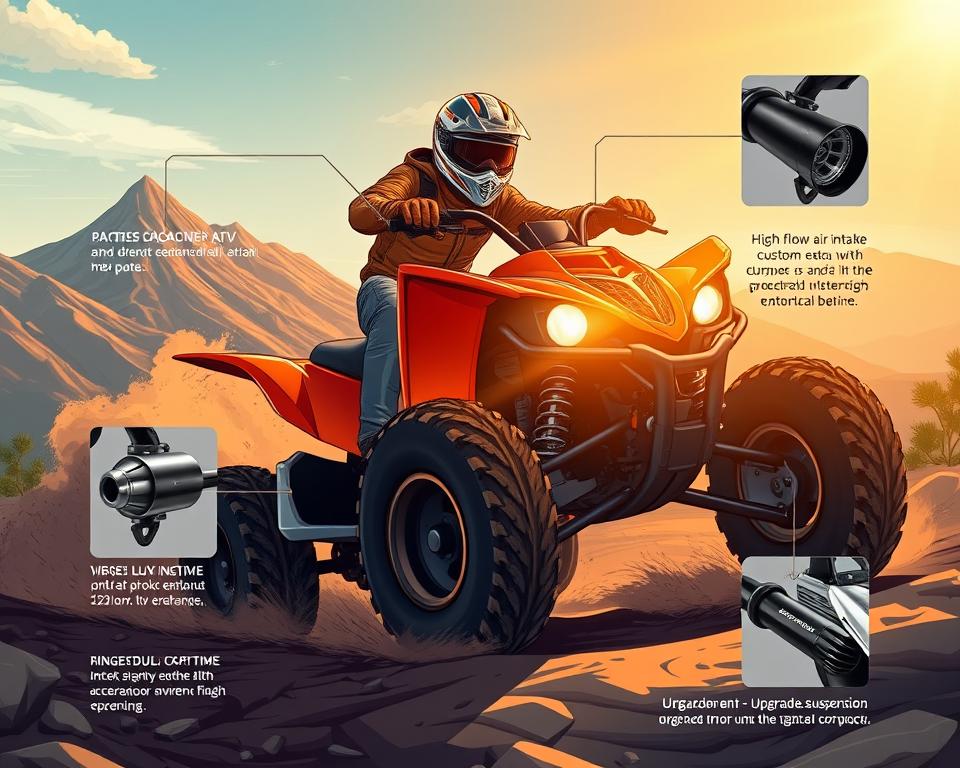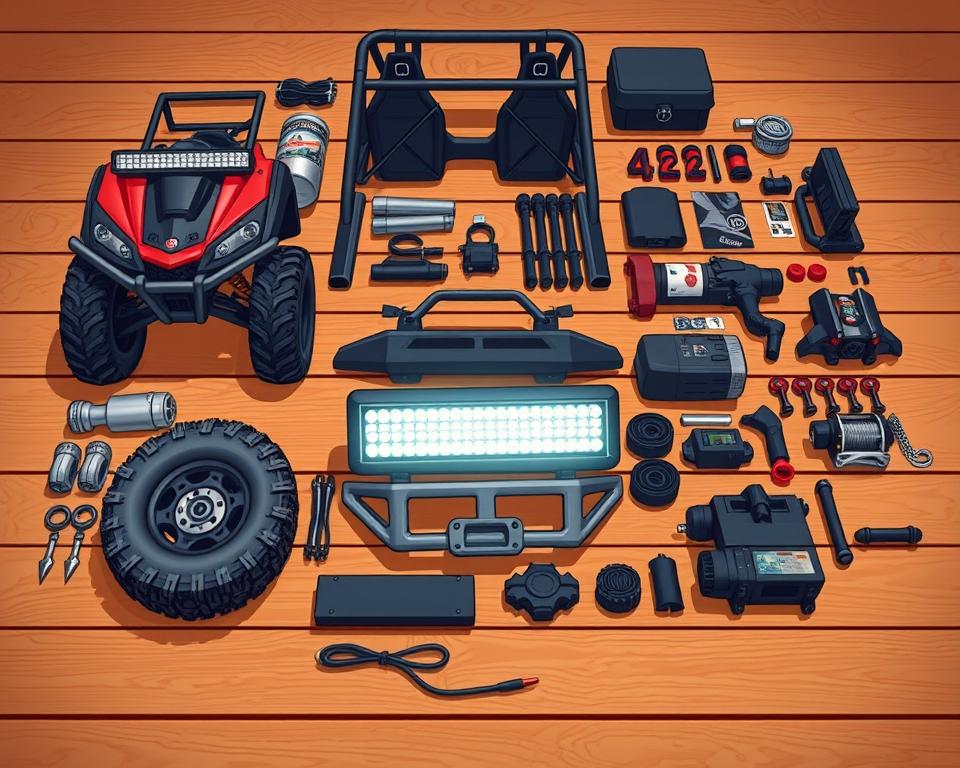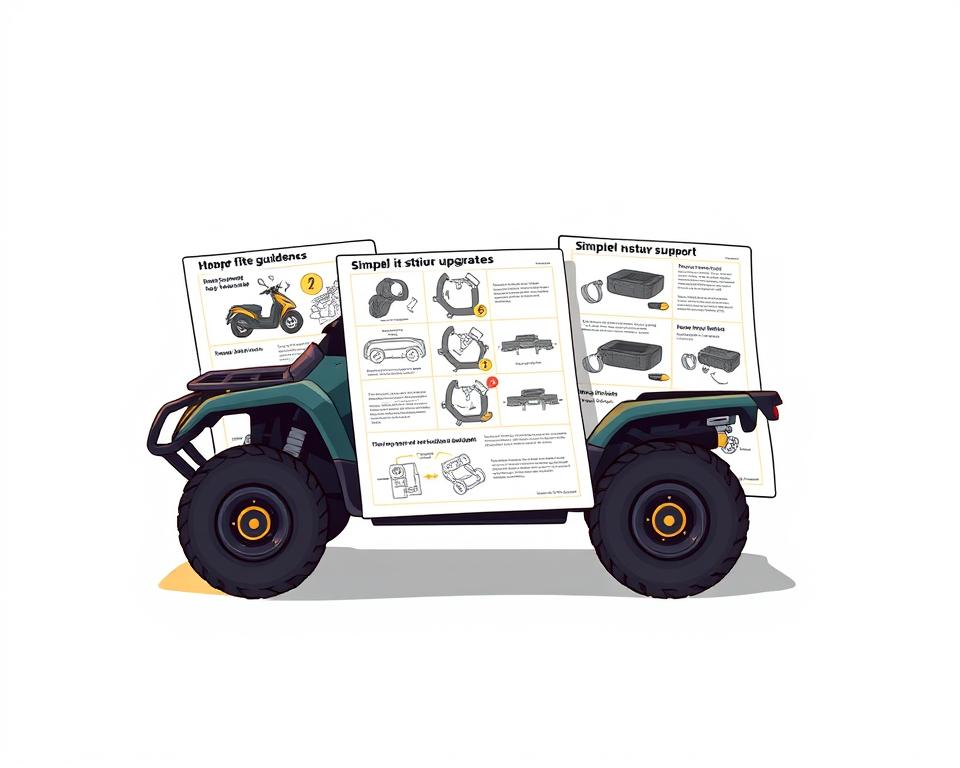Must-Have ATV Off-Road Safety Checklist
Did you realize nearly approaching half a million ATV-related injuries are treated in U.S. emergency rooms each year? That startling statistic underscores why off-road safety and preparation are essential. The Essential ATV Off-Road Checklist is your guide to a safe and enjoyable ride. From boulder-strewn tracks to shifting sands—it’s got you covered. Armed with proper safety equipment and Can Am renegade lift kit must-haves, you’ll reduce hazards and amplify the fun.
Key Takeaways
- Prioritize safety by using the Essential ATV Off-Road Checklist for optimal preparation.
- Don’t hit the trail without this ATV safety gear list.
- Maintenance matters: check often, ride better.
- Water and snacks—musts for long off-road sessions.
- Master your GPS and maps to stay on track.
- Pack layers and waterproofs for all conditions.
- Trailside fixes? Have your toolkit and recovery gear ready.
Understanding the Importance of Safety Gear
When you ride off-road, safety must come first. ATVs deliver thrills—and risks. Proper gear guards you against mishaps. Being well-equipped ensures a safer ride and follows an ATV safety gear checklist.

Essential Protective Gear
Maximizing protection involves several key items:
- Riding Helmets: Only DOT-certified lids will protect your skull.
- Eye Protection: Use goggles to shield your eyes from dust and debris.
- Gloves: Wear durable gloves for better grip and hand protection.
- Footwear: Wear sturdy boots that cover the ankles to prevent injuries.
- Body Armor: Aggressive riders should consider body armor for extra security.
- Neck Braces: Neck braces can help reduce the risk of spinal injuries.
Emergency Preparedness
Being ready for emergencies is critical. A well-packed kit might save your life. Key items to include are:
- First aid kit
- Multi-tool
- Tire repair kits
- Portable air compressors
- Emergency blankets
- Whistles
- Matches
ATV Equipment for Optimal Performance
Gear choices affect how well your ATV runs. Pack these essentials for any trail. Regularly following an ATV maintenance checklist helps maintain your machine’s functionality and longevity.
Must-Have ATV Equipment
- Durable Tires: Invest in tires designed for various terrains to improve traction and handling.
- Storage Solutions: Use efficient storage compartments for tools and emergency supplies, ensuring quick access when needed.
- Quality Fuel Tank: Never run low—use a proven fuel tank.
- First Aid Kit: Prepare for emergencies with a well-stocked first aid kit for immediate attention if needed.
Regular Maintenance for Longevity
Routine care keeps breakdowns at bay. Regular inspections should encompass:
- Inspect and clean or replace air filters regularly.
- A well-lubed chain spins quietly and reliably.
- Ensure pads and discs are in prime condition.
This ATV maintenance checklist is essential for keeping your vehicle in peak condition and ready for adventure.
The Essential ATV Off-Road Checklist
Good prep keeps surprise breakdowns away. An effective ATV maintenance checklist ensures your vehicle’s safety and performance. Each pre-ride inspection step requires attention to detail. A thorough pre-ride assessment is key to a safe outing.
Pre-Ride Inspection Basics
Before any off-road journey, a pre-ride inspection is vital. Catch faults early with a fast inspection. Key elements to check include:
- Tire pressure and tread condition
- Fluid levels such as oil and fuel
- Brakes and controls functionality
- Operational lights and horn
- Chain or driveshaft integrity
T-CLOC Inspection Method
The T-CLOC method offers a systematic approach to inspection. It covers Tires and Wheels, Controls, Lights, Oil and Fuel, and Chain/Driveshaft. This method ensures all critical areas are covered:
| Inspection Area | Checklist Items |
|---|---|
| Tires and Wheels | Check tire pressure, inspect tread depth, look for damage |
| Controls | Test brakes, throttle, and clutch for smooth operation |
| Lights | Ensure headlights, brake lights, and indicators are functioning |
| Oil and Fuel | Check oil level, inspect for leaks, and fill fuel tank |
| Chain/Driveshaft | Examine for wear, proper tension, and lubrication |
Spending a few minutes on this ATV maintenance checklist can make rides safer and more enjoyable. Keep the adventure going with no surprises.
Hydration and Nutrition for Long Rides
Don’t underestimate water and snacks on extended outings. Always carry more water than you think you’ll need. Carry extra water to prevent fatigue and keep energy levels up during the adventure. Nutritious snacks power you through rough stretches.
Importance of Staying Hydrated
Hydration is critical for ATV riders to stay alert and capable throughout their journey. Sipping regularly prevents performance drops. Hydration bladders track consumption at a glance.
High-Energy Snacks to Pack
Choosing the right snacks is vital for extended ATV rides. Pack portable, long-shelf treats. Some ideal choices include:
- Protein bars
- Nut mixes
- Dried fruits
- Beef jerky
Grab-and-go snacks let you refuel on the move. Ensure to pack a variety to keep your energy levels high and your taste buds satisfied.
Navigation Tools for Off-Roading Adventures
Stay on course with proven navigation aids. Don’t rely on luck or signals—use real navigation.
Advanced GPS Systems
An advanced GPS system is a must for off-road adventures. Look for features like offline maps and a long-lasting battery. Garmin and TomTom lead the pack for trail GPS.
Traditional Navigation Aids
Technology is key, but traditional tools are also essential. A compass never needs a signal. Wind your own way with map and compass skills. Combining advanced tech with traditional aids prepares you for any situation on your journey.
Communication Equipment for Safety
Stay in touch even off the grid. Using reliable ATV communication gear is vital for safety. Knowing you can call for help reduces stress.
Group rides need reliable radios. Opt for radios rated for miles of reach. Get instant alerts about obstacles ahead. When choosing two-way radios, look for models with:
- Weatherproof construction to resist the elements
- Long battery life for extended trips without needing a recharge
- Channel selection for clear communication without interference
Always include comms in your gear list. They keep everyone coordinated and secure. When reception is zero, your radio still works. Clear comms = better rides.
Self-Rescue Gear for ATV Riders
Self-rescue gear is as vital as your helmet. Self-rescue gear for ATVs is key to handling challenges on your own. Prepared riders make safer group members.
Winches and Recovery Kits
Winches are vital for self-rescue, helping pull your ATV from tough spots. A winch paired with a detailed ATV recovery kit is even more effective. Recovery kits usually include:
- Tow straps
- D-rings
- Recovery boards
- Gloves
Knowledge plus gear equals true self-rescue. Be ready for anything the trail throws at you.
Trail Recovery Essentials
Pack these extras along with your winch. These include:
| Equipment | Purpose |
|---|---|
| Recovery Straps | Used for towing or pulling ATVs out of tight situations. |
| Shovel | Helps clear obstacles and dig out vehicles when stuck. |
| Traction Mats | Provides grip under tires in muddy or slick conditions. |
| Portable Air Compressor | Enables quick tire inflation after deflating for better traction. |
Don’t rely on luck—bring the right tools. Skills plus gear equal top-tier off-road safety.
Staying Adaptable: Preparing for Weather Changes
Expect the unexpected in the outdoors. Your comfort and safety depend on proper weather prep. Pack for every possible forecast.
Layer up, shed as needed. A dry base keeps you cozy. Mid-layers trap heat and pack small. Your shell fights off wind and rain. Adapt to cold, heat, or storms easily.
Weather-Appropriate Clothing
- Rain Shells: Stay dry when the sky opens up.
- Breathable Pants: Stay cool and dry with breathable pants.
- UV Gear: Lightweight, long-sleeved shirts and wide-brimmed hats safeguard against harmful UV rays.
- Insulated Gloves: Insulate your hands against cold snaps.
Don’t let the weather ruin your ride. It keeps you comfortable and safe, letting you enjoy the adventure without worrying about the weather.
Tools for On-Trail Repairs
Essential repair tools are a rider’s best friend. Don’t skimp on repair gear. These tools help address minor breakdowns or issues that may arise during your adventure.
Must-Have Tools and Kits
No ride is complete without a toolkit. Pack only the essentials—no junk. Critical ATV repair tools might include:
- Tire irons for changing flat tires
- Pliers for gripping and cutting
- Wrenches for various sizes of bolts and nuts
- A multi-tool for versatility
- Spare items such as spark plugs and electrical wire
- Duct tape for quick fixes
Be your own mechanic on the trail.
Basic Emergency Supplies
In addition to essential tools, packing basic emergency supplies for ATV is vital. These supplies help ensure your safety in challenging situations:
- First aid kit for injuries
- Flashlight with extra batteries for night-time visibility
- Emergency whistle for signaling assistance
- Reflective triangles or flares to warn other riders
- Water and high-energy snacks for sustenance
Be ready for the unexpected. Always keep these ATV repair tools and emergency supplies handy.
Final Thoughts
Well-planned rides are the best rides. Follow this checklist and choose quality gear. This ensures you’re ready for any terrain.
Gear up fully and ride securely. Effective planning is vital for both safety and performance. It lets you enjoy the thrill of off-road adventures without worry.
Be prepared, ride safe, and make great memories. Every leg of the trip matters. Check this list, then conquer nature.
Frequently Asked Questions
What should I include in my ATV safety gear checklist?
Your ATV safety gear checklist should include a DOT-approved helmet and goggles. Gloves, suitable footwear, and body armor are also necessary. Neck braces offer additional protection. Also bring a medical kit and adaptable multi-tool.
Tips for ATV upkeep?
Inspect air filters and grease the chain often. Don’t ignore brake checks. Routine care prolongs longevity and readiness.
What does the T-CLOC inspection method entail?
T-CLOC inspects five critical systems. Tires, Controls, Lights, Oil, and Chain are checked in T-CLOC. T-CLOC confirms all systems go for trail use.
How much water should I bring on an ATV trip?
Carrying more water than you think you’ll need is essential. Stay topped off to avoid dehydration. Use a hydration bladder for quick sips.
What should I bring for navigation during my off-road adventure?
For navigation, invest in an advanced GPS system designed for off-road use. Also carry a compass and laminated maps.
Role of radios on the trail?
Comms keep groups connected and safe. In no-signal zones, radios shine.
What self-rescue gear should every ATV rider carry?
Pack a winch plus full recovery gear. Include straps, shackles, and traction boards.
How to handle trail weather swings?
Use a base, mid, and shell layering system. Don’t get caught soaked—bring waterproofs. Don’t forget sunscreen and UV-blocking apparel.
What tools should I pack for on-trail repairs?
A compact tool set lets you fix flats and loose bolts. Have spares and tape for quick fixes.


